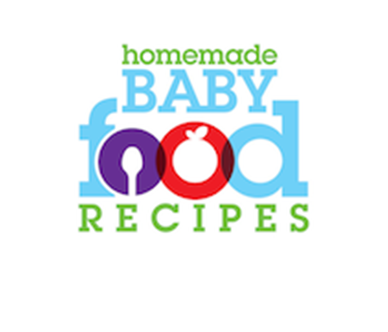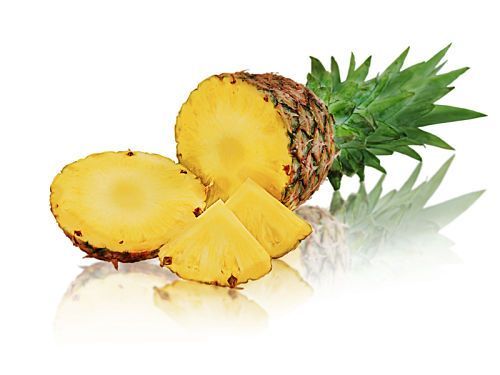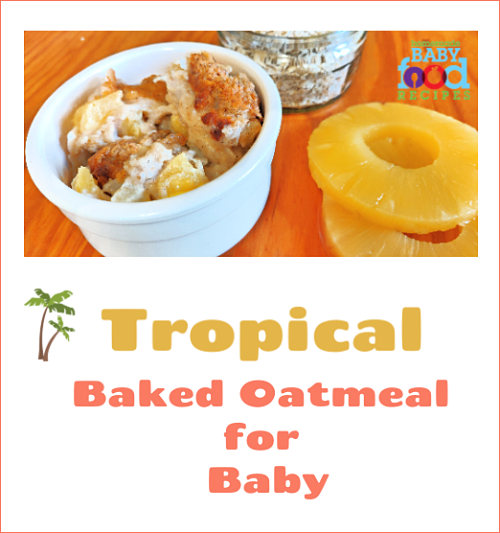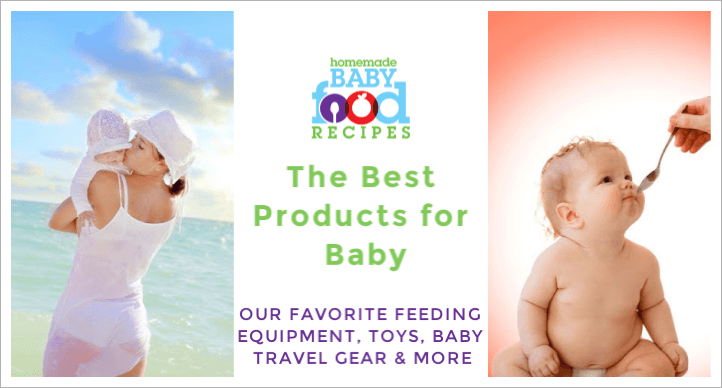Pineapple Baby Food Recipes and Tips
Updated: June 17, 2023
Is it time to introduce your baby to pineapple baby food?
Find out here and try our tasty baby food recipes with this tropical fruit!
When can my baby eat pineapple?
Pineapple doesn’t seem to be a particularly common allergen, but one problem it DOES present as a baby food is that it’s very acidic.
Fresh pineapple and pineapple juice can cause a nasty diaper rash.
Even canned pineapple may have a similar effect, although in our experience the reaction is far more extreme with fresh.
In some cases, the acids in pineapple may even cause a rash around baby’s mouth.
Generally, this isn’t a sign of an allergic reaction to pineapple (although you should always check with your doctor to be sure).
Instead, it's simply baby’s delicate skin reacting to the strong acids.
Even adults sometimes experience this reaction.
For these reasons, pineapple is NOT appropriate as a first food for baby.
It is far better to introduce it in the latter part of baby’s first year (9 months onwards), when his digestive system has become used to coping with a wider variety of foods.
Even then, it is best to introduce pineapple slowly, a little at a time, mixed into other foods.
Not until you are completely sure that your baby won’t react to its acidity should you think about offering chunks of pineapple to gnaw on.
And you should always be VERY careful offering pineapple wedges or chunks – the fruit can be very fibrous, presenting a possible choking hazard.
SPECIAL NOTE: Pineapple is commonly responsible for flare ups in babies with infant reflux and is best avoided.
Read more about infant reflux and solid foods here….
Pineapple nutrition facts
Pineapple is a great source of dietary fibre, manganese, vitamin C and vitamin B1.
It has anti-inflammatory properties and is considered a wonderful aid to digestion.
This is thanks to the bromelain it contains – a digestive enzyme that breaks down protein.
In fact, this enzyme is so good at its job that fresh pineapple juice is sometimes used to tenderize meat!
Note: If you add fresh pineapple to gelatin/jelly, it will not set.
This is because the bromelain breaks the gelatin down.
Canned pineapple, however, does NOT contain bromelain, as it is destroyed during processing – therefore, if you want to make a pineapple jelly for the family, use the canned variety!
Choosing the fruit
When looking for a pineapple for your baby, see if you can find one labelled ‘Extra Sweet’ or ‘Gold’, which won’t be as tart for your little one.
Unlike many other fruits and vegetables, size doesn’t matter when it comes to pineapple – large or small, the taste, texture and nutritional value will be more or less the same.
The pineapple should, however, be heavy for its size.
The fruit should be ripe when you buy it, because pineapples don’t ripen any further once picked.
You can tell if a pineapple is ripe by sniffing it near the stem – it should smell sweet and pleasant.
You can also try pulling out one of the leaves from the crown – it should come out easily if the fruit is ripe.
WARNING: Never offer unripe pineapple to your baby (or eat it yourself, for that matter).
It can cause diarrhea, vomiting and irritation to the throat.
Pineapple connoisseurs recommend keeping the fruit at room temperature for a couple of days before serving it.
This improves the texture by making it juicier and softer.
The pineapple can then be stored in the refrigerator for around 5 days.
Once you’ve cut the pineapple, store it in an airtight container in the fridge.
The flesh can dry out quite quickly, but you can maintain its juiciness by storing it in water or juice (preferably pineapple juice).
It will keep like this for several days, but – as with all foods intended for baby – we recommend using it within 1 to 2 days.
Which is best for baby – fresh pineapple or canned?
If you are able to find truly fresh, succulent pineapple than that, of course, is the most nutritious choice for your baby.
However, in areas where fresh pineapple is rarely – if ever – available, then canned pineapple makes an acceptable alternative.
Be sure that the fruit is packed in fruit juice – not syrup. Canned pineapple is less acidic than fresh and some babies prefer it!
Read more about using canned fruits and veggies in your baby food recipes
How to cut and peel a pineapple
There are two ways of doing this…
METHOD ONE
- Cut off the stem end and base of the pineapple.
- Stand it on its end and – using a sharp knife – peel it in long strips down its length.
- Once you’ve removed all the skin and ‘eyes’, turn it on its side and slice it.
- Cut out the circular core in the centre of each slice.
Handy tip!
Save the pineapple flesh from the base of the fruit for your baby. That’s where the sugars are concentrated – consequently, it will be softer and sweeter.
METHOD TWO
(which we find quicker)
- Cut off the stem end and base of the pineapple.
- Stand the pineapple on end and cut in half lengthwise.
- Cut again, crosswise, so the pineapple is now in quarters.
- Lay each quarter on its side and cut off the core along its length.
- Using a sharp knife, remove the skin (in the same way as you’d remove the skin from a fish!).
Should I buy organic pineapple for my baby?
Pineapple does not appear on the Environmental Working Group’s list of the fruits and vegetables most likely to be contaminated by pesticide residues – the Dirty Dozen.
For one thing, the skin has to be removed – and for another, the skin’s thickness provides an effective defence against the absorption of pesticides.
Read more about pesticide residues and the merits of peeling produce for your baby
It is not important, therefore, to buy organic pineapple.
Pineapple baby food ideas
Fresh pineapple is yummy when mashed or pureed with…
If the pineapple you are using is particularly tough and hard to mash, try cooking it briefly by steaming or simmering in a little water or juice until tender.
Pineapple baby food recipes
Simple pineapple yogurt
1 pineapple ring
pure maple syrup
- Drizzle the pineapple ring with a little maple syrup.
- Place under a hot broiler (grill) and cook until it begins to brown.
- Turn and repeat on the other side.
- Cool until just warm, then puree in a food processor.
- Stir into yogurt and serve.
Super-sweet sweet potato!
1 small sweet potato, peeled and diced
4 fl oz (1/2 cup) soy milk
1 pineapple ring, chopped
pinch cinnamon
1 tsp unsalted butter (optional)
- Simmer the sweet potato dice in the soy milk over a low heat, until tender.
- Transfer to a bowl and mix with the chopped pineapple and cinnamon.
- Check the temperature and serve.
Pineapple-y Pork
4 oz (1/2 cup) pork loin, chopped
8 fl oz (1 cup) low sodium or homemade chicken stock
1 small sweet potato, peeled and diced
1 pineapple ring, chopped
- Mix the chopped pork and sweet potato dice in a saucepan and pour in the stock.
- Bring to the boil, then lower the heat and simmer, covered, for 5 mins.
- Add the pineapple and continue to cook until the pork is cooked through and the sweet potato is tender (5 to 10 mins).
- Mash or puree, then serve.
Foil Wrapped Chicken and Pineapple
1/2 chicken breast, bonelss and skinless
1 pineapple ring
1 small apple, peeled, cored and cut into rings
1 tbsp fresh basil, chopped
- Preheat the oven to 400 deg F (200 deg C).
- Take a square of foil and lay the pineapple ring in the centre.
- Place the chicken on top of the pineapple, then lay the apple rings over the top of the chicken.
- Sprinkle with the basil.
- Bring together the sides of the foil and seal to form a parcel.
- Bake for 30-45 mins, until the chicken is cooked through and the juices run clear.
- Chop or puree and serve with brown rice.
Vegetarian Squash and Pineapple Treat
1/2 acorn squash, seeds removed
1 tsp apple juice
1 tsp pure maple syrup
1 tbsp unsalted butter
1 oz (1/8 cup) crushed pineapple
pinch ground nutmeg
- Preheat the oven to 425 deg F (220 deg C).
- Place the squash in a greased, lidded baking dish.
- In the hollow of the squash, add the apple juice and maple syrup. Rub 2 tsp of the butter into the surface of the squash.
- Bake, covered, for 30 mins.
- Remove from oven and, using a spoon, scoop out the flesh of the squash, leaving a shell around 1/4 inch thick.
- Place the squash flesh in a bowl and combine with the rest of the butter, the pineapple and the nutmeg.
- Mash well.
- Return the squash mixture to the shell then bake for a further 15 mins.
- Cool and serve (you can use the squash skin as the ultimate organic bowl!).



